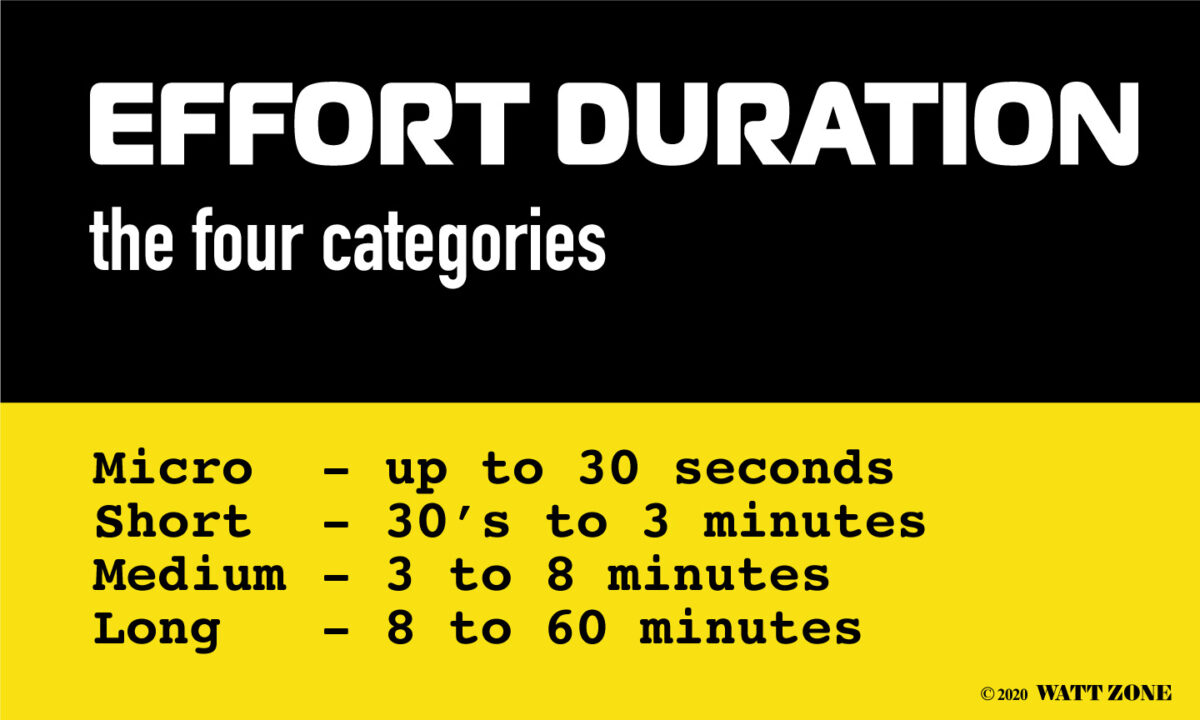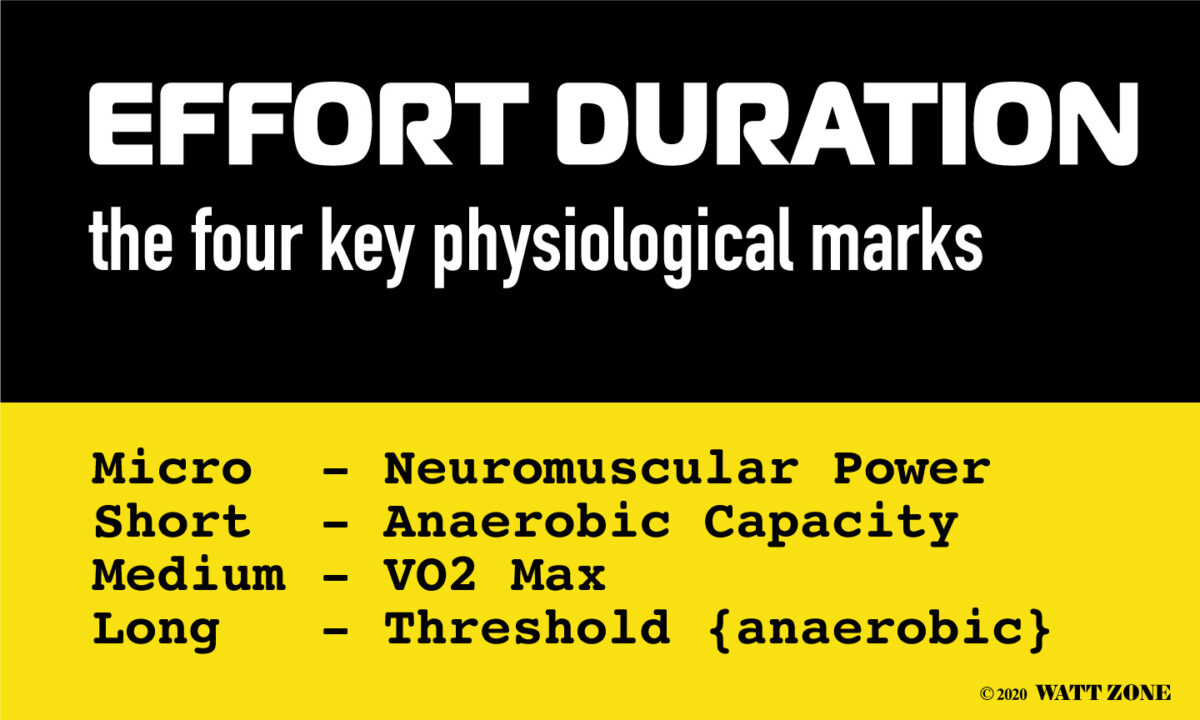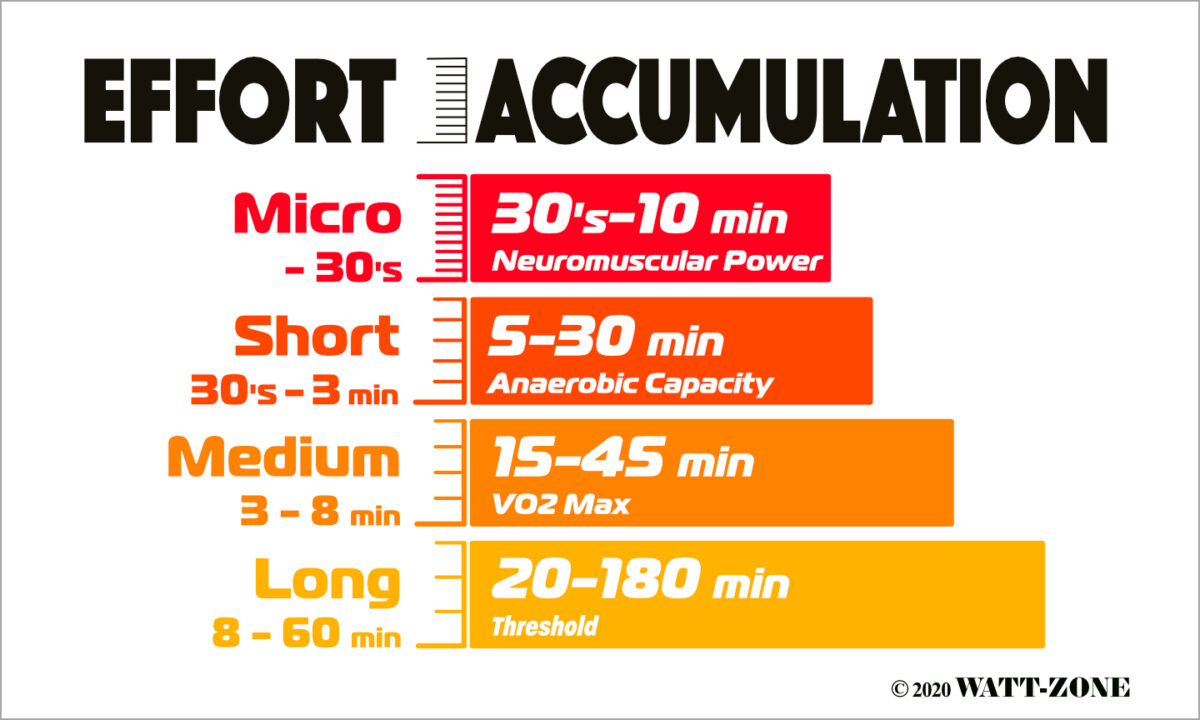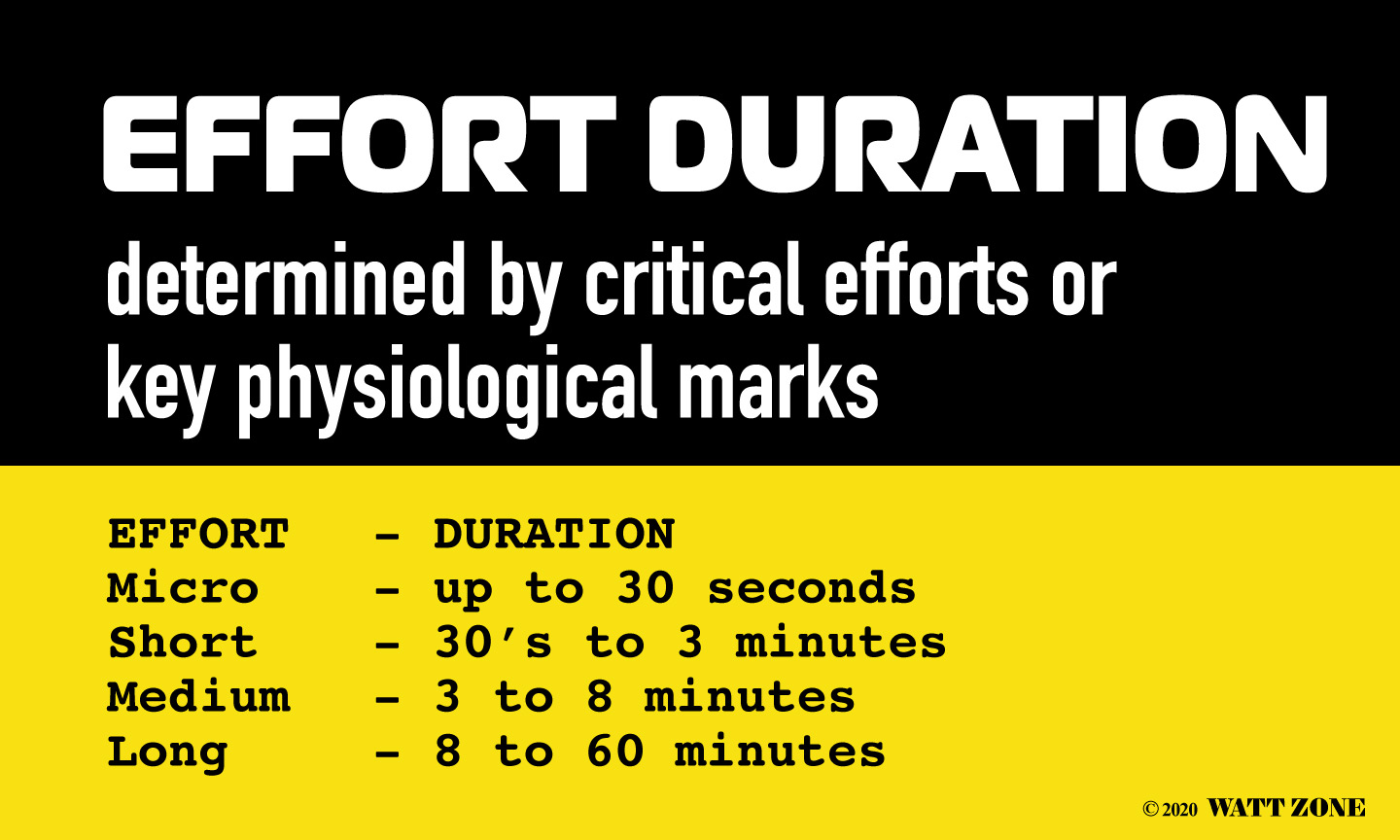Effort Duration for Accumulation Rides is extremely important. Effort Duration plays a major role in determining the intensity of an Accumulation Ride. In the Accumulation model Effort Duration is split into four simple categories; Micro, Short, Medium, and Long. Finally, these categories correlate to optimizing four key physiological marks; Neuromuscular Power, Anaerobic Capacity, VO2 Max, and Anaerobic Threshold respectively.
To recap, an Accumulation Ride is where a cyclist accumulates time at High-Effort (exercise above the Aerobic Threshold and beyond the Anaerobic Threshold). Accumulation Rides represent traditional interval training, but with an emphasis on the accumulated time at High-Effort. Correspondingly Effort Duration represents interval length. Choosing the optimal Effort Duration has always been a major question for athletes in all sports.
The Accumulation model strives to give a framework for determining the optimal Effort Duration. In this section, Effort Duration for Accumulation Rides, the question of how to determine effort duration will be answered. Please note, it’s best that you have read about Accumulation and the Four Rides before progressing.
Four Categories of Effort Duration

At Watt-Zone, we have split, Effort Duration into four categories; Micro, Short, Medium, and Long. Obviously, this gives a simple structure that cyclists easily understand and communicate. In terms of actual time, the Effort Duration range for these categories are as follows:
- Micro – up to 30 seconds,
- Short – 30 seconds to 3 minutes
- Medium – 3 minutes to 8 minutes
- Long – 8 minutes to 60 minutes
Key Physiological Marks

The Effort Duration categories have been designated because of their ability to optimize 4 key physiological marks that are extremely important for cyclists;
- Micro – Neuromuscular Power
- Short – Anaerobic Capacity
- Medium – VO2Max
- Long – Threshold {anaerobic}
In essence, performing an Effort anywhere within the specified time range of a category, is likely to aid in optimizing the associated Key Phisiological Mark. For example performing a 10 minute Long Effort will aid in optimizing one’s Anaerobic Threshold.
The categorisation of the Efforts helps a cyclist determinewhat Effort Duration they should choose. For example: Should I do 4 minutes? 5 minutes? or 8 minutes?
All of these interval durations fall into the Medium Effort Duration Category: 3 to 8 minutes. So the answer as to which is best is somewhat mute. They are all Medium Efforts and will all help optimize VO2 max. Perhaps the question the cyclist should be asking is: do I want to improve VO2 Max?
In addition, if the answer is yes, perhaps the more important question is. What’s the optimal Accumulation, for me, for performing Medium – Vo2 Max Efforts? We look at this question here – Optimal Accumulation.
Shaping One’s Fitness
All of these physiological marks are important for a cyclist. But as with many things, you can’t have it all. So some choices inevitably have to be made.
This is why we say Accumulation is where a cyclist shape’s their fitness. By choosing Accumulation training to optimize either Neuromuscular Power, Anaerobic Capacity, Vo2 Max, or Anaerobic Threshold, a cyclist is choosing the shape, or what their fitness will look like.
It should be noted, however, that the different physiological marks are to some extent inter-related. Improving one can help improve another. For example, if one improves Anerobic Threshold, it is likely that Vo2 Max will also improve.
There are a few rules, a cyclist should keep in mind, with respect to the 4 categories of Effort Duration:
- Firstly, it is most effective to focus on one Effort Duration category at a time.
- Secondly, it is most effective to focus on one Effort Duration category for between 4 to 8 weeks.
- Thirdly, it is not generally advisable to train two Effort Duration Categories within a single training session.
Determining Effort Duration
Cyclists should perform Effort durations that correspond to Key Physiological Marks that they wish to maintain or improve. How they choose these is really up to them. It has been popular for cyclists to focus on Long Intervals, Anaerobic Threshold, for general cycling performance.
Once general targets for Key Physiological marks have been achieved. Cyclists may then tune their accumulation leading up to goal rides, to focus on critical efforts they will encounter.
Critical Efforts
At a more specific level, a cyclist should use the concept of critical efforts, to determine which of the 4 Key Physiological Marks they should emphasize in training.
Critical Efforts are required for key moments in a race that determine the outcome. It is imperative that cyclists analyze races ahead of time. So they can determine what the key moments will be. And consequently what Critical Efforts they need to focus on. It may be a 3-minute maximum effort on a final climb or a 20-minute effort on a false flat.
Whatever the Critical effort is, the cyclist should complete Efforts in training that match this, to ensure they are in the best possible shape to perform optimally. Effort Durations of 3 minutes and 20 minutes would correspond to Medium and Long Effort Durations. So they should perform Efforts in both these Categories.
You can read more about critical efforts here.
Effort Intensity

Obviously now that we have an idea how to choose the Effort Duration, the next question is at what intensity should the Effort be done? In the Accumulation Ride introduction we recognized that when performing an Accumulation Ride, Efforts should be performed at a maximum repeatable intensity. Thus, Desired Accumulation and Effort Duration interact to determine the overall intensity of a training session. This concept is expanded on more in the Optimal Accumulation section.
Summary
Effort Duration for Accumulation Rides are extremely important, they play a major role in shaping one’s fitness. In the Accumulation model, Effort Duration is split into four categories; Micro, Short, Medium, and Long. Which correlate to optimizing four key physiological marks; Neuromuscular Power, Anaerobic Capacity, VO2 Max, and Anaerobic Threshold respectively.

